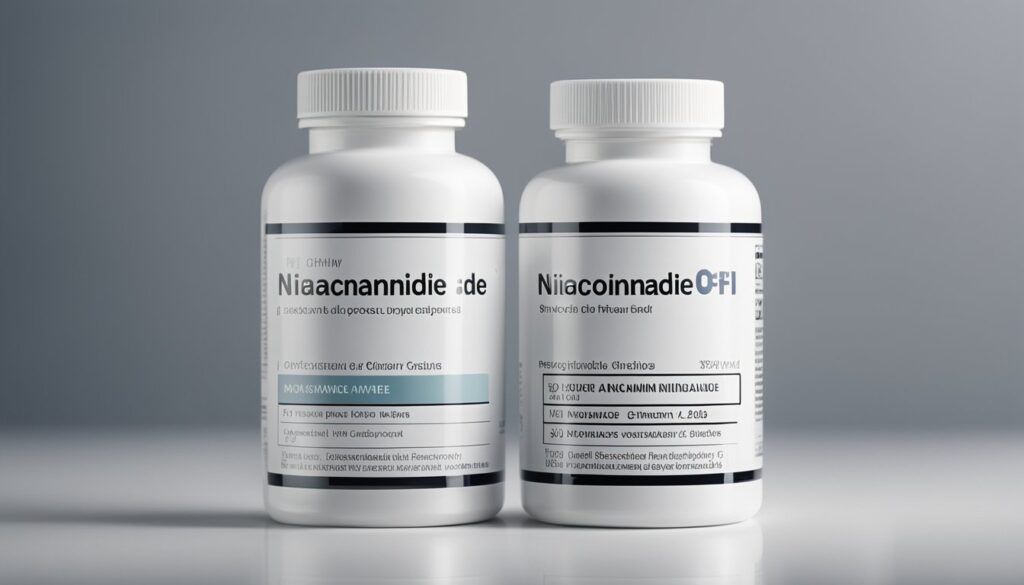Niacinamide, a form of vitamin B3 also known as nicotinamide, is an essential nutrient found in various foods and available as a dietary supplement. While it plays a crucial role in maintaining your skin health and supporting your body’s metabolism, there’s a growing conversation around the safety of its supplementation, particularly when consumed in high doses. It is important to consider the potential adverse effects that may arise from exceeding the recommended amounts.

The healthcare landscape acknowledges niacinamide’s myriad benefits, but it urges a cautious approach when integrating it into your daily regimen. Responsible supplementation is key, as high-dose nicotinamide has been associated with a range of unwanted side effects. Before altering your vitamin intake, it’s imperative to consult with a healthcare provider to ensure that your health and safety remain uncompromised.
To make an informed decision about taking niacinamide supplements, a clear understanding of both its advantages and potential risks is essential. While beneficial in standard doses, the significance of adhering to guidance from healthcare professionals cannot be understated, as they can help navigate the complexities of supplement use and prevent possible toxicity.
Niacinamide Toxicity and Safety

Understanding the balance between niacinamide’s beneficial uses and its potential for toxicity is critical for safe consumption. Key aspects include its mechanisms of toxicity, symptoms, risk factors, proper treatment, and safety considerations.
Mechanisms of Toxicity and Body Response
Niacinamide, a form of vitamin B3, plays a pivotal role in energy metabolism within your cells, particularly the mitochondria. High doses, however, may lead to oxidative stress and disturbances in cell function. This can result in an overaccumulation of nicotinamide metabolites causing hyperphosphatemia and an increase in liver enzymes.
Symptoms and Adverse Effects
Excess niacinamide can manifest as a series of side effects ranging from mild, such as itching, flushing, and headache, to more severe reactions like rash, diarrhea, bruising, bleeding, burning sensations, vomiting, and nausea. Consistent high intake may exacerbate these symptoms.
Risk Factors and Population Vulnerabilities
Certain groups, like children, those who are pregnant, and individuals with chronic kidney disease, diabetes, or type 1 diabetes, are at increased risk of toxicity. Gallbladder disease patients and those on medications like carbamazepine or primidone should also be cautious due to potential adverse interactions.
Treatment and Management of Toxicity
In cases of toxicity, the primary step is consulting a healthcare provider for proper evaluation and treatment. This may involve discontinuing niacinamide use and managing symptoms. Severe cases might require medical intervention to address any complications and normalizing liver enzymes. Monitoring and managing health outcomes is a continuous process during and after treatment.
Precautions and Interactions
Niacinamide has interactions with certain medications, particularly anticoagulant / antiplatelet drugs, and conditions including stomach or intestinal ulcers. It is recommended for you to inform your healthcare provider about all medications you’re taking to avoid adverse interactions.
Regulatory and Safety Profile
Niacinamide’s safety profile has been evaluated in various clinical trials, establishing a recommended dietary allowance (RDA) to avoid side effects. Despite its anti-inflammatory properties, long-term use at high doses beyond the RDA is not advised without supervision of a healthcare professional. Different formulations may have variable safety profiles, highlighting the importance of adhering to regulatory guidelines.
Niacinamide in Skin Health and Diseases

Niacinamide, also known as nicotinamide, is a form of vitamin B3 used in various skin treatments from acne management to skin cancer prevention. Your understanding of its effects is critical for its safe and effective application.
Therapeutic Uses and Efficacy
Niacinamide is recognized for its role in treating multiple skin conditions. It’s a cornerstone treatment for acne due to its anti-inflammatory properties, reducing the severity of breakouts and associated redness. Studies have shown niacinamide can be beneficial in the management of skin cancers, including nonmelanoma types, by bolstering cell immunity and repair.
In the realm of aging skin, niacinamide has been found to improve the appearance of wrinkles, hyperpigmentation, and skin elasticity. By enhancing skin barrier function, it assists in moisture retention and protection against environmental damage, which is critical for maintaining skin health.
Modulation of Inflammatory Processes
Niacinamide’s anti-inflammatory effects extend beyond acne treatment; they can relieve symptoms of other inflammatory skin diseases such as rosacea and eczema. It does this by inhibiting the body’s inflammatory responses and may play a role in reducing insulin resistance, a benefit that can aid in the management of conditions like osteoarthritis.
Niacinamide in Cosmetic Dermatology
Within cosmetic dermatology, niacinamide is favored for its versatility and safety profile. It can improve skin texture and tone by moderating the transfer of melanin to the skin, which can reduce the incidence of hyperpigmentation. Moreover, niacinamide is included in an array of skin care products aimed at aging skin. It supports the production of keratin, a protein that keeps your skin firm and healthy.
Products containing niacinamide are often recommended as a staple in a comprehensive skin care routine due to these benefits, with a particular emphasis on its ability to prevent and repair signs of skin aging and damage.
Frequently Asked Questions

In this section, we cover some of the most common queries about the potential toxic effects and safe usage of niacin, also known as Vitamin B3, to better understand the balance between its benefits and risks.
What are the recognized symptoms associated with excessive intake of niacin?
When you consume niacin in excess, you may experience symptoms like flushing, itching, gastrointestinal distress, and in severe cases, liver toxicity. Overdose may also lead to more serious conditions like hyperglycemia and gout.
How can niacin overdose be effectively treated?
If you suspect a niacin overdose, it’s important to seek medical attention immediately. Treatment typically involves stopping the intake of niacin and providing supportive care, which can include hydration and monitoring for complications.
Apart from its role in sexual health, what are other benefits of niacin supplementation?
Niacin supplementation can benefit your health beyond sexual wellness. It’s essential for energy metabolism, skin health, and may help with cholesterol management. Niacin has also been touted for its ability to improve cognitive function.
At what dosage does niacin begin to pose a risk of liver damage?
Liver damage is a potential risk when taking high doses of niacin, particularly at amounts exceeding 2,000 mg per day. However, even lower doses can sometimes cause liver enzyme elevations, so regular monitoring is recommended.
What are the common side effects one might experience when using niacinamide?
Common side effects of using niacinamide include mild burning, itching, or redness of the skin when applied topically. Oral niacinamide can cause stomach upset and headache, among other side effects.
Has niacin been discredited in the treatment of certain conditions, and if so, why?
While niacin has been used to treat various conditions, its role has been reassessed in some instances, such as cholesterol management, due to a lack of evidence supporting its efficacy and concerns over safety at high doses.